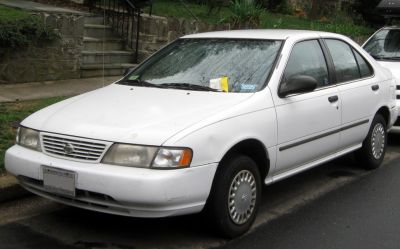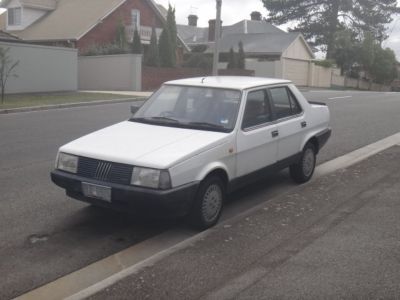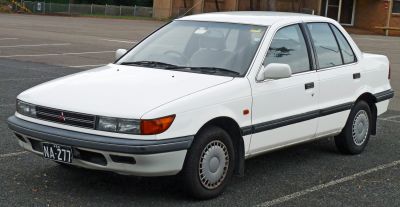 1972 Audi 80 (B1, Typ 80) Dimensions, Size & Specs
1972 Audi 80 (B1, Typ 80) Dimensions, Size & SpecsMeasurements of the 1972 Audi 80, engineered for optimal performance and comfort
| Dimensions | |
|---|---|
| Length: | 4175-4220 mm164.4-166.1 in13.7-13.8 ft |
| Width: | 1600 mm63.0 in5.2 ft |
| Height: | 1362 mm53.6 in4.5 ft |
| Trunk Capacity: | 432-450 liter15.3-15.9 cu ft |
| Weight Specifications | |
| Curb Weight: | 835-880 kg1841-1940 lbs |
| Maximal permitted Weight: | 1260-1300 kg2778-2866 lbs |
| Tire Specifications | |
| Rims Size: |
|
| Tire Size: |
|
The Audi 80 (B1, Typ 80) generation, produced from 1972 to 1976, represents Audi's entry into the compact sedan segment during the early 1970s. This model blends classic styling with efficient dimensions that suited the urban and suburban driver of its era. The sedan measures between 4175 mm and 4220 mm in length (approximately 164.2 to 166.1 inches), making it relatively compact yet roomy enough for practical daily use. Its width stands at 1600 mm (about 63 inches), providing a balanced stance on the road while maintaining good maneuverability for city driving. The vehicle's height is a modest 1362 mm (roughly 53.6 inches), contributing to a low center of gravity and sporty handling characteristics characteristic of Audi’s engineering philosophy.
Weighing between 835 and 880 kilograms (approximately 1,841 to 1,940 pounds) curb weight, the Audi 80 B1 is a lightweight vehicle offering efficiency and responsive driving dynamics. The maximum permissible weight ranges from 1260 to 1300 kilograms (2,778 to 2,866 pounds), accommodating passengers and cargo comfortably. Speaking of cargo, the sedan offers a generous luggage capacity ranging from 432 to 450 liters (roughly 15.3 to 15.9 cubic feet), which is quite practical for a vehicle in this class and era.
Completing its technical profile, this generation of the Audi 80 rides on 13-inch rims fitted with tires sized 175/70 R13, ensuring a smooth ride and adequate road grip typical of compact sedans of the 1970s. Overall, the Audi 80 B1 stands as a classic model that combines functional dimensions, adequate interior and cargo space, and a lightweight design that continued to pave the way for future Audi compact sedans.
Discover the standout features that make the 1972 Audi 80 a leader in its class
Have a question? Please check our knowledgebase first.
The Audi 80 (B1, Typ 80), manufactured from 1972 to 1976, ranges in length from 4175 mm to 4220 mm (164.4 to 166.1 inches). This slight variation depends on specific model trims or configurations produced during that period. The compact length was typical for sedans of its era, balancing interior space and maneuverability for urban and suburban driving.
The width of the Audi 80 (B1, Typ 80) is 1600 mm (62.99 inches). Compared to other early 1970s sedans, this width is fairly standard for a compact executive car, providing adequate interior space for passengers without making the vehicle overly bulky. Its width made it nimble in city traffic while maintaining comfortable cabin dimensions.
The height of the Audi 80 (B1, Typ 80) is 1362 mm (53.58 inches). This relatively low height contributes to a sleeker profile and helps improve the car’s aerodynamic performance, which was beneficial for fuel efficiency during its production time. The height also supported a comfortable cabin headroom while maintaining a sporty sedan appearance.
This generation of the Audi 80 has a curb weight ranging from 835 kg to 880 kg (1841 to 1940 lbs). Being relatively lightweight, the car offered nimble handling and efficient fuel consumption. The lighter weight combined with its compact dimensions also contributed to more responsive acceleration and easier maneuverability in urban traffic compared to heavier vehicles.
The maximum permissible weight (gross vehicle weight) for the Audi 80 (B1) ranges between 1260 kg and 1300 kg (2778 to 2866 lbs). This indicates the total weight of the vehicle plus passengers, cargo, and fuel that it can safely carry. This capacity was typical for compact sedans, making it practical for everyday use without sacrificing performance or reliability.
The luggage capacity of the Audi 80 (B1, Typ 80) ranges from 432 to 450 liters (approximately 15.25 to 15.88 cubic feet). This size offers generous room for a compact sedan, suitable for typical family outings or travel needs of the 1970s. It enables carrying multiple suitcases or large items, making the car versatile for daily errands and longer trips.
Yes, the Audi 80 (B1, Typ 80) fits comfortably into a standard residential garage. Its length of up to 4220 mm (166.1 inches) and width of 1600 mm (62.99 inches) are well within the common garage size of roughly 6 meters (20 feet) long and 3 meters (10 feet) wide. Its compact dimensions ensure ease of parking without taking up excessive space, making it suitable for typical home garages.
The Audi 80 (B1) was the brand’s first generation of this model, introduced in 1972, so it did not have a direct predecessor within the same model line. However, compared to earlier Audi sedans like the Audi F103 series, the B1 80 was more compact and purpose-built as a mid-size sedan with modern design and improved aerodynamics. This represented a shift towards more efficient packaging and modernization in dimensions.
The Audi 80 (B1) aligns closely with other European compact sedans of the early 1970s, such as the BMW 2002 and Mercedes-Benz W114. With a length around 4.2 meters, width of 1.6 meters, and curb weight between 835 and 880 kg, it was competitive in providing balanced interior space and lightweight construction. Its compact footprint favored sporty handling while maintaining everyday usability, putting it in direct competition with its contemporaries in the category.
The Audi 80 (B1, Typ 80) came equipped with 13-inch rims fitted with 175/70 R13 tires. This tire size was typical for compact and mid-size sedans of the 1970s, providing a good balance between ride comfort, handling, and traction. The relatively narrow width and moderate sidewall height contributed to its smooth driving characteristics and ease of maintenance.
Discover similar sized cars.

| Production: | 1994-1999 |
|---|---|
| Model Year: | 1995 |
| Length: | 4230 mm166.5 in |
| Width: | 1670 mm65.7 in |
| Height: | 1395 mm54.9 in |

| Production: | 1983-1990 |
|---|---|
| Model Year: | 1984 |
| Length: | 4260 mm167.7 in |
| Width: | 1650 mm65.0 in |
| Height: | 1410 mm55.5 in |

| Production: | 1988-1994 |
|---|---|
| Model Year: | 1988 |
| Length: | 4235 mm166.7 in |
| Width: | 1670 mm65.7 in |
| Height: | 1405 mm55.3 in |

| Production: | 2001-2012 |
|---|---|
| Model Year: | 2001 |
| Length: | 4235 mm166.7 in |
| Width: | 1670 mm65.7 in |
| Height: | 1395 mm54.9 in |
